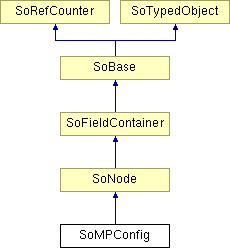SoMPConfig Class Reference
 Specifies the behavior of the MultiPipe viewer.
More...
Specifies the behavior of the MultiPipe viewer.
More...
#include <Inventor/MP/Xt/SoMPConfig.h>

Public Types | |
| enum | Threads { PARALLEL = 0, SEQUENTIAL = 1 } |
| enum | Multipipe { INSIDE_OUT = 0, INSIDE = 1 } |
Public Member Functions | |
| virtual SoType | getTypeId () const |
| SoMPConfig () | |
| ~SoMPConfig () | |
Static Public Member Functions | |
| static SoType | getClassTypeId () |
Public Attributes | |
| SoSFEnum | threads |
| SoSFEnum | multipipe |
Detailed Description
 Specifies the behavior of the MultiPipe viewer.
Specifies the behavior of the MultiPipe viewer.
The SoMPConfig node is used in the MultiPipe configuration file. SoMPConfig has two fields that modify the behavior of the MultiPipe viewer: threads and multipipe.
NOTE: This class does not exist in Open Inventor 10.0 and later.FILE FORMAT/DEFAULT
- MPConfig {
- Inventor/MP/Xt/SoMPConfig.h
| threads | PARALLEL |
| multipipe | INSIDE_OUT |
Member Enumeration Documentation
| enum SoMPConfig::Threads |
Constructor & Destructor Documentation
| SoMPConfig::SoMPConfig | ( | ) |
Constructor.
| SoMPConfig::~SoMPConfig | ( | ) |
Destructor.
Member Function Documentation
| static SoType SoMPConfig::getClassTypeId | ( | ) | [static] |
Returns the type identifier for this class.
Reimplemented from SoNode.
| virtual SoType SoMPConfig::getTypeId | ( | ) | const [virtual] |
Returns the type identifier for this specific instance.
Reimplemented from SoNode.
Member Data Documentation
Specifies the viewer's behavior.
Use enum Multipipe. Default is INSIDE_OUT.
If set to INSIDE, the MultiPipe viewer behaves like a regular viewer: the image is displayed inside the main viewer and the SoFlatScreen nodes are ignored.
Specifies the thread mode.
Use enum Threads. Default is PARALLEL.
If set to SEQUENTIAL, all MultiPipe windows are rendered one after an other (thread-safe). No threads are created. If set to PARALLEL (default value), the MultiPipe windows are rendered in parallel, by threads. ScaleViz creates as many threads as there are SoFlatScreen or SoScreen nodes.
The PARALLEL setting for the thread field is preferred because each screen has its own render thread and they are all running in parallel, especially if multiple processors are available. For best performance, there should be at least as many processors as screens. However, note that all code executed during the render traversal must be "thread safe," including application callbacks and custom nodes. SEQUENTIAL mode can be used to drive multi-screen displays when parts of the code are not thread safe.
The documentation for this class was generated from the following file: